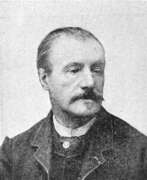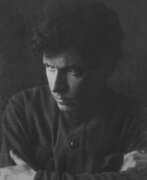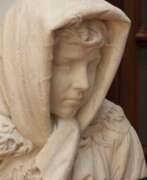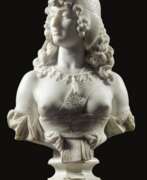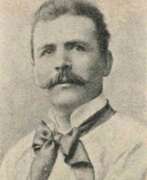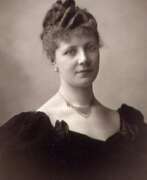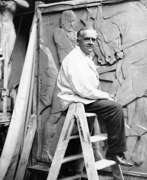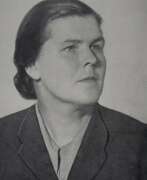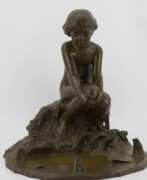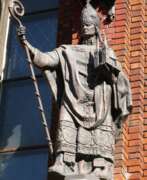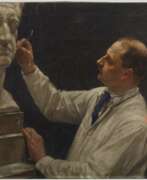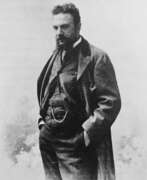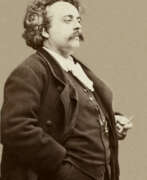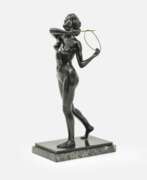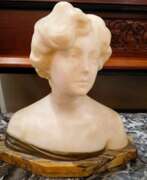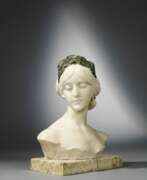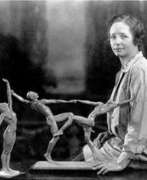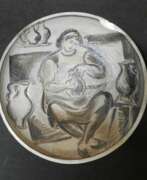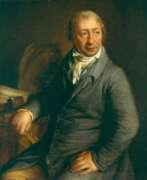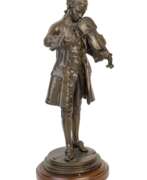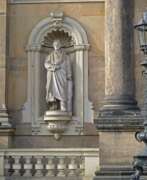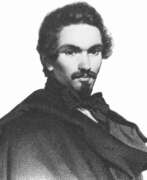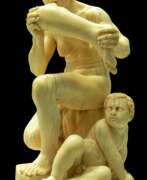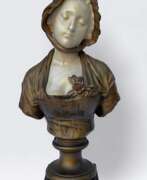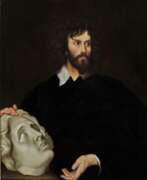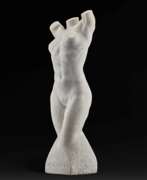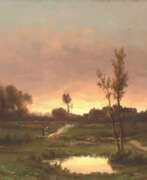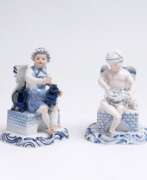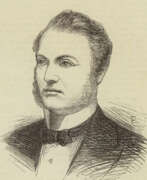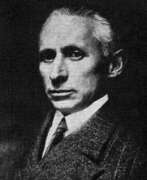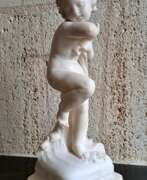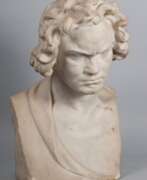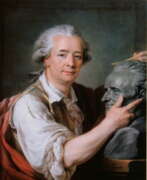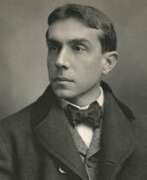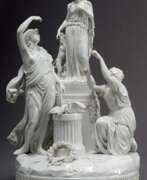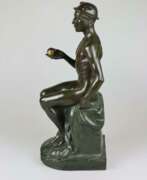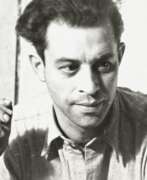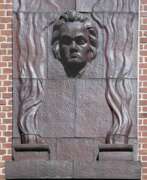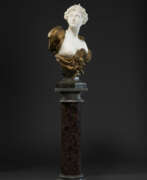Portrait sculpture Classicism
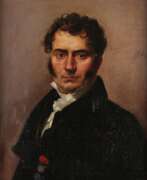

André-Joseph Allar was a French sculptor. He studied at the Schools of Fine Arts in Marseille and Paris with Eugène Guillaume, Antoine Laurent Dantan and Pierre-Jules Cavelier.
André-Joseph Allar is best known for his small works and architectural projects.
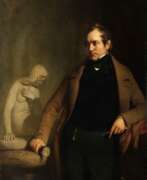

Edward Hodges Baily was a prolific English sculptor responsible for numerous public monuments, portrait busts, statues and exhibition pieces as well as works in silver. He carved friezes for both the Marble Arch and Buckingham Palace in London. His numerous statues of public figures include that of Horatio Nelson on top of Nelson's Column and Charles Grey, 2nd Earl Grey on Grey's Monument in Newcastle upon Tyne. Throughout his career Baily was responsible for creating a number of monuments and memorials for British churches and cathedrals, including several in St Paul's Cathedral.
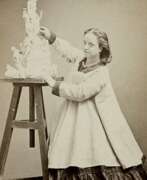

Hélène Bertaux, born Joséphine Charlotte Hélène Pilate, was a French painter and sculptor who achieved equal rights with men.
Hélène Pilate trained as a teenager in the workshop of her stepfather Pierre Hébert, where she modeled designs for watches, then regularly received commissions for small decorative bronze pieces. Aspiring to become a professional sculptor, she completed her studies with Augustin Dumont (1801-1884) in the academic tradition. The support of the imperial couple enabled her to become one of the few women to make a name for herself in the field of monumental sculpture: in 1864 she created the Fontaine Herbet for the Place Longueville in Amiens and during her career she received several prestigious commissions for religious and public buildings.
After achieving success and official recognition, Hélène Bertaux advocated for equality between men and women in the arts. In 1873, Hélène Bertaux opened her first sculpture studio, and in 1879, she opened another one with a sculpture school for women. Her students, including Clémence-Jeanne Eymard de Lanchâtre (1854-1894) and Jenny Weil (1851-1933), later won prizes at the Salon. The creation in 1881 of the Union of Women Painters and Sculptors, of which she was president from 1881 to 1894, marked a new step in her fight for gender equality in academic education. Hélène Bertaux became the first female member of the Salon jury and received a gold medal at the 1889 World's Fair.
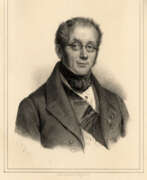

François Joseph Bosio was a French Neoclassical sculptor.
François Joseph Bosio was a pupil of the sculptor Augustin Pajou. With the support of the latter he made a study trip to Italy, where he studied statues by antique masters. He was also court sculptor to Kings Louis XVIII and Charles X.
At that time, he was favored by the French monarchs: Napoleon I decorated him with the Legion of Honor, Louis XVIII awarded him with the royal order of Saint Michail, he became an Institute of France member (in 1816) and in 1822, was granted the title of royal sculptor.
He was the director of the Academy of Fine Arts in Paris. The influence of Antonio Canova is noticeable in his sculptures.
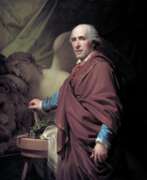

Antonio Canova was an Italian sculptor of the late 18th and early 19th centuries. He is known as a bright representative of neoclassicism in European fine art. Canova was a follower of traditions of artists of antiquity and Renaissance. Among admirers of his creativity there were many representatives of ruling dynasties of Europe.
Antonio Canova himself created more than 50 statues, and together with his assistants - about 180 works. He gained influential patrons and had a reputation as the most important European sculptor of his time. Among his customers was Napoleon Bonaparte, whose statue Canova carved from marble, depicting the emperor as Mars.
Most of Canova's works today decorate the expositions of the world's leading museums, such as the halls of the Louvre and the Hermitage.
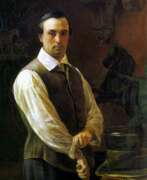

Peter Jakob Freiherr Clodt von Jürgensburg (Russian: Пётр Карлович Клодт фон Юргенсбург) was a Russian sculptor of Baltic German descent, renowned for his significant contributions to Russian monumental art during the reign of Nicholas I. Born on June 5, 1805, in Saint Petersburg, Clodt initially embarked on a military career before pursuing his artistic ambitions. He studied at the Imperial Academy of Arts in Saint Petersburg, where he honed his skills in horse sculpture, eventually earning acclaim from the Emperor himself.
Clodt's most celebrated works include the "Horse Tamers" sculptures on the Anichkov Bridge, unveiled in 1851, and the first monument to a poet in the Russian Empire, the statue of Ivan Krylov in the Summer Garden (1848-1855). His mastery in equestrian statues is evident in the Monument to Nicholas I on Saint Isaac's Square, notable for its technical innovation as the world's first equestrian statue supported solely by the horse's two rear legs. This piece, installed between 1856 and 1859, remains a historic achievement in sculptural engineering.
Clodt's works are celebrated for their dynamic representation and precision in detail, characteristics that have kept his legacy alive in the realms of Russian and European art. His sculptures can be viewed in various prominent locations across Saint Petersburg, serving as cultural landmarks that attract both art aficionados and general tourists.
For those interested in the history of Russian sculpture and the works of Peter Jakob Freiherr Clodt von Jürgensburg, staying updated on exhibitions and auctions can provide unique insights and opportunities. Sign up for updates on new product sales and auction events related to this master sculptor to ensure you don't miss out on valuable collectibles and exhibits.
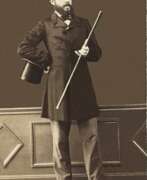

Charles Cordier, full name Charles Henri Joseph Cordier, was a French painter and innovative sculptor.
Charles Cordier studied in Paris at the École des Beaux-Arts and during his studies met a black sitter, a former slave, this meeting and predetermined his future creative life. In 1848, when slavery was officially abolished in all French colonies, Cordier exhibited his first plaster bust of a Sudanese man and received his first success.
For fifteen years, from 1851 to 1866, Cordier was the official sculptor of the Musée National d'Histoire Historique in Paris, creating a series of busts for the ethnographic gallery. Collecting images and types of various ethnic groups, the artist traveled extensively throughout Italy, Greece, Egypt, and Algeria, as well as France itself. Cordier's works are notable for their striking naturalism, and he also made spectacular use of the colors of various materials - marble of different shades, onyx and bronze, silvering and enamel.
Cordier openly defended the advanced for that time the idea of equality of all races. "Each race," he declared, "has its own special type of beauty. The most beautiful black man is not at all the one who looks more like a white man than anyone else."
Cordier also worked on the sculptural decoration of the Paris Opera House, the Louvre, and the Paris Town Hall. His son was the sculptor Henri Louis Cordier.
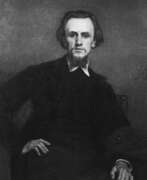

Guillaume De Groot is a Belgian sculptor.
He studied in the studio of sculptor Egid Melo, a pupil of Guillaume Gifs, as well as at the Brussels Academy. De Groot is the author of chandeliers, allegorical figures, bas-reliefs, statuettes and monumental works. He created many sculptures located in public spaces in Brussels and adorning historic buildings. His works can also be found in the Royal Museum of Fine Arts in Antwerp.


Mathias Gasteiger is a German sculptor, painter and entrepreneur.
He studied at the Munich Academy of Art and was a pupil of Victor Tilgner in Vienna at the time when he was working on a monument to Mozart in Burggarten made of Lassa marble. Later, Gasteiger was involved in the development of equipment for the extraction and transportation of Lasa marble.
Mathias Gasteiger founded his Munich residence in the Hern district, which became a social center for prominent artists. Gasteiger created several sculptures that are now very popular in Munich.
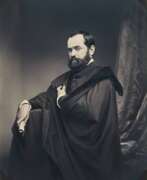

Ernst Julius Hähnel was a German sculptor, professor at the Dresden Academy of Arts.
His main interest for Ernst Hähnel was portraiture. His statues show a clear idealisation of his heroes in the spirit of the ancient tradition.


John Edward Jones was a noted Irish civil engineer and sculptor, active in Dublin and London.
In 1839 he was awarded a Telford Medal in silver and 20 guineas for his paper and drawings on the sewage in Westminster.
In 1840 Jones ceased his engineering practice to become a sculptor in London, with considerable success, particularly in portrait busts of notables including Queen Victoria and Albert, Prince Consort. He exhibited at the Royal Academy from 1854 to 1862.
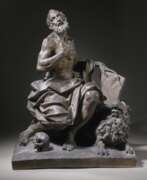



Franz Xaver Messerschmidt was an 18th-century Austrian sculptor. He is known as a master of the grotesque and caricature. Messerschmidt became famous after his death. During his lifetime his contemporaries considered him at best an extravagant freak, and at worst mentally ill, although no documentary evidence of the sculptor's mental illnesses has yet been found.
Franz Xaver Messerschmidt was an adherent of Classicism at the initial stage of his work. But then the artist decisively abandoned the principles of classical art. He became famous for making a large series of busts, which the sculptor himself called "heads". The faces of the characters in these works are distorted by all kinds of grimaces and display vivid human emotions. All in all Messerschmidt managed to produce more than 50 heads, which during his lifetime did not arouse the interest of potential customers.
In January 2005, the Louvre acquired one of the "heads" at an auction Sotheby's for a record price of 4 800 000 U.S. dollars.
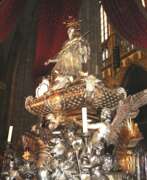

Ignác František Platzer the Elder or Ignác Franz Platzer (German: Ignaz Franz Platzer) was a Czech-Austrian late Baroque and Classicist sculptor and carver. He was court sculptor of Austrian emperors of the Habsburg dynasty.


Ernst Friedrich August Rietschel was a German sculptor and one of the greatest representatives of Classicism. His monuments for Goethe and Schiller in front of the Stadttheater in Weimar and his monument for Lessing in Braunschweig are world-famous works of art, representing the creative genius of Germany.
Ernst Ritschel studied at the Dresden Academy of Fine Arts. He was professor of sculpture and an honorary member of the Academies of Fine Arts in Paris, Rome, Antwerp, Copenhagen and Brussels.
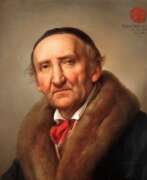

Johann Gottfried Schadow was a renowned German-Prussian sculptor, celebrated for his significant contributions to Neoclassical sculpture. Born in Berlin in 1764, Johann Gottfried Schadow's artistic journey led him to become one of the most respected sculptors of his time, with his works still admired for their classical beauty and expressive detail.
Johann Gottfried Schadow's most notable works include the Quadriga atop the Brandenburg Gate and the Princess Group, a sculpture depicting the Prussian princesses Louise and Frederike, which exemplifies his neoclassical style and attention to detail. His sculptures, characterized by their idealized but naturalistic representation, reflect Schadow's mastery in capturing the essence of his subjects with a classical grace that was ahead of his time.
His influence extended beyond his sculptures, as Johann Gottfried Schadow was also a key figure in the Berlin art scene, shaping the artistic direction of the era. His works are preserved in various locations, including the Alte Nationalgalerie in Berlin, where visitors can admire his artistry and the historical significance of his sculptures.
For collectors and art enthusiasts, Johann Gottfried Schadow's legacy offers a fascinating glimpse into the neoclassical movement and its impact on European art history. His dedication to portraying beauty, nobility, and historical significance through sculpture continues to inspire and captivate audiences, making his works highly revered in the realm of art and culture.
For those intrigued by Johann Gottfried Schadow's enduring legacy and eager to stay informed about the latest updates related to his artwork and exhibitions, we invite you to sign up for updates. This subscription will keep you abreast of new product sales, auction events, and exhibitions related to Schadow's masterpieces, ensuring you remain connected to the vibrant world of art history and the impactful contributions of Schadow to neoclassical sculpture.
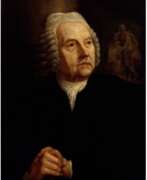

Peter Scheemakers the Younger was a Flemish sculptor considered the founder of modern sculpture in England.
He trained under his sculptor father in Antwerp, and came to England around 1721 and created tombstones and garden sculpture in a restrained classical style. In 1728 Scheemakers traveled to Rome to study sculpture and, returning to London in 1730, earned a reputation as one of the outstanding sculptors of his day.
In 1741 he executed his most famous work, a monument to William Shakespeare in Westminster Abbey.
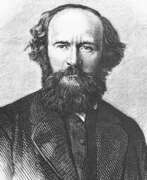



Ludwig Michael Schwanthaler, ennobled as Ritter von Schwanthaler, was a Bavarian sculptor and a key figure in the Classical movement in southern Germany. He was born on 26 August 1802 in Munich to a family that had been involved in sculpture for centuries.
Schwanthaler's journey began under his father's tutelage before he formally trained at the Munich Academy. His talent was so profound that he received commissions from royalty and mentorship from the likes of Peter von Cornelius. He further honed his skills in Rome, where he was influenced by Bertel Thorvaldsen. Returning to Munich, Schwanthaler met the demands for sculpture head-on, collaborating with architects and painters to revive the arts in Bavaria.
Among his many works, the statues in the Neues Palais and the figures in the Alte Pinakothek are notable. His versatility also shone in sacred art, with his contributions to St Ludwig and St Mariahilf churches. The Ruhmeshalle's metopes and the monumental Bavaria statue demonstrate his artistic bravery. Schwanthaler's life was dedicated to his craft, and upon his death on November 14, 1848, he bequeathed his models and studies to the Munich Academy, forming the Schwanthaler Museum.
For art enthusiasts, Schwanthaler's legacy offers a deep dive into classical sculpture's golden age. His works remain a testament to the neoclassical aesthetic and are celebrated for their historical and artistic significance.
Engage with the grandeur of Schwanthaler's art by signing up for updates, and take part in preserving the memory of one of Bavaria's master sculptors.


Ferdinando Vichi was a famous Italian sculptor.
Ferdinando was fascinated by art from childhood and soon enrolled at the Academy of Fine Arts in Florence. He later worked in Germany, France, England, both Americas and India. International critics were very complimentary of the young Vichi, who was not yet twenty years old.
Ferdinando Vichi was a prolific and respected sculptor in Florence in the last half of the 19th and first half of the 20th century. He worked primarily with marble, taking inspiration from classical, renaissance and mythological works. His historical-romantic sculptures were very popular: "Cupid and Psyche", "The Seasons" and others are consistently admired by the public.
Ferdinando Vichi created many commissioned sculptural portraits, including three American presidents, McKinley, Roosevelt and Taft. He has also erected numerous monuments to the fallen in Italian cities, a monument to Senator Donato Marelli and a large number of tombs of famous families in England, Switzerland.
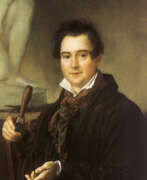

Ivan Petrovich Vitali (Russian: Иван Петрович Витали) was a Russian sculptor and artist of Italian origin of the 19th century, a representative of Classicism. He was named Giovanni at birth, but his Russian name stuck. Vitali is best known as the author of the rich decoration of St. Isaac's Cathedral in St. Petersburg.
Ivan Vitali had no professional academic education, but his biography is a model of a successful career as the son of an Italian immigrant who achieved recognition through hard work and talent. Vitali's works adorn the squares and museums of the two Russian capitals, Moscow and St. Petersburg.
Vitali was one of the founders of the Moscow Art Society, on the basis of which the famous School of Painting, Sculpture and Architecture was formed a few decades later.
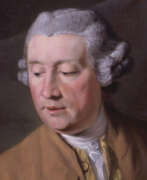

Joseph Wilton was an English sculptor. He was one of the founding members of the Royal Academy in 1768, and the academy's third keeper. His works are particularly numerous memorialising the famous Britons in Westminster Abbey.
